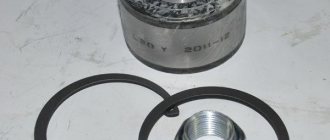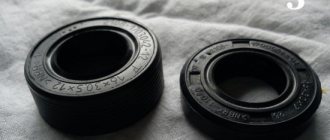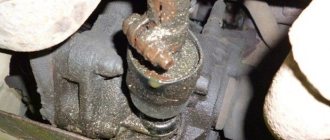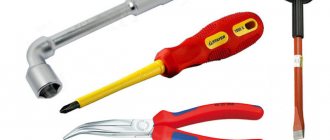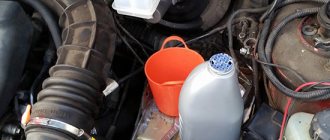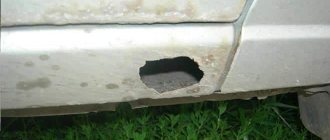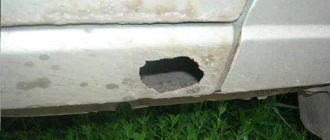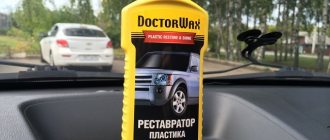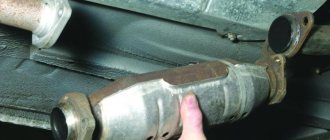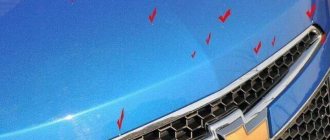Layout of bearings in VAZ 2107 units
| Explanation of positions on the bearing arrangement diagram |
| 1 — differential bearing, 2 — wheel bearing of the VAZ 2107 rear axle , rear axle drive gear rear support bearing, 4 — rear axle drive gear front support bearing, 5 — universal joint bearings, 6 — propeller shaft support bearing, 7 — rear support bearing secondary shaft of a four-speed gearbox, 8 - bearing of the secondary shaft of a five-speed gearbox, 9 - hub bearing of the VAZ 2107 external support of the front wheel, 10 - bearing of the internal support of the front wheel hub, 11 - bearing of the generator support on the drive side, 12 - bearing of the generator support on the rectifier side , 13 — bearing of the front support of the gearbox input shaft, 14 — bearing of the clutch release clutch, 15 — bearing of the front support of the gearbox intermediate shaft, 16 — bearing of the rear support of the input shaft of a five-speed gearbox, 17 — bearing of the front support of the gearbox secondary shaft, 18 — rear support bearing intermediate shaft of the four-speed gearbox, 19 — fifth-stage gear block bearing, 20 — toothed belt tension mechanism, 21 — fluid cooling pump bearings, 22 — steering wheel shaft bearing, 23 — bearing of the upper support of the steering gear worm. 24 — bearing of the lower support of the steering gear worm. |
Layout of bearings in VAZ 2107 units with a four-speed gearbox
CARBURETOR VAZ 2107
Layout of bearings in VAZ 2107 units with a five-speed gearbox
Replacing the axle bearing
It is quite difficult to replace a bearing yourself, but it is possible. This process is very labor-intensive and time-consuming. To replace the bearing you will need about two hours of free time. The most important point in this process will be the availability of all the necessary tools to carry out the replacement efficiently:
- Jack.
- Devices for strengthening the raised body. (can be replaced with a removed wheel)
- Balloon wrench.
- Wheel stops.
- Reverse hammer. (can replace removed brake drum)
- Keys for 8 and 12.
- Socket or socket wrench size 17.
- Vise, workbench. (working with a vice is safer)
- Slotted screwdriver.
- Blowtorch or gas torch
- Bulgarian.
- Hammer and chisel
- Pliers.
- Grease and rags.
Wheel bearing of the front wheel of a VAZ 2107
Interior
internal wheel bearing of the front wheel of the VAZ 2107 is roller, tapered. There are 2 of them on the car.
Type of wheel bearing brand 6-7805U:
Design of wheel bearing brand 6-7805U:
Designation of the internal bearing of the front wheel hub:
- According to VAZ classification - 2101-3103020;
- According to the bearing plant classification - 6-7805U.
Dimensions of the front wheel rear wheel bearing:
- Outer diameter D - 57.15 mm;
- Inner diameter d - 26 mm;
- Thickness B - 17.46 mm.
| Technical characteristics of wheel bearing 6-7805U | |
| Accuracy class | 6 |
| Separator | steel |
| GOST | 27365-87, 333, 520-2011 |
| Country of origin | Russia |
Outer
Outer wheel bearing 6-7804U for the front axle VAZ 2107, roller, tapered. There are 2 of them for cars.
Type of wheel bearing brand 6-7804U:
Design of outer wheel bearing 6-7804U:
Front wheel outer wheel bearing designation:
- According to VAZ classification - 2101-3103025;
- According to the classification of the bearing plant - 6-7804U;
- International designation - LM 11949/910/Q.
In the designation of bearing 6-7804U, the letter “U” stands for special technical requirements (strict requirements for roughness, rotation accuracy, etc.)
Wheel bearing dimensions:
- Outer diameter D - 45.52 mm;
- Inner diameter d - 19.05 mm;
- Thickness B - 16.63 mm.
| Technical characteristics of wheel bearing 6-7804U | |
| Accuracy class | 6 |
| Separator | steel |
| GOST | 27365-87, 333, 520-2011 |
| Country of origin | Russia |
Auto repair school - Do-it-yourself car repair
Apr 1, 2016 VAZ 2101, VAZ 2102, VAZ 2105, VAZ 2106, VAZ 2107, Zhiguli, Classic by admin
In the previously published article “ It’s time to replace the rear axle bearing or... ” a way to eliminate knocking in the rear axle axle in VAZ 2101, VAZ 2105, VAZ 2106, VAZ 2107 , and it also said, I quote: “I would like to note right away that independently you can remove or change the axle shaft, as well as eliminate the bearing play in the seat. But replacing the bearing itself requires special tools and certain skills.” To this we can add that in all repair and maintenance manuals for the VAZ 2101 car and their modifications you will not be able to find a detailed description of how to replace the axle bearing with your own hands. Instead of instructions in these manuals, you will only find recommendations, such as: “replacing the axle bearing must be carried out at a specialized service station” or “replacing the lock ring and bearing on your own is not recommended.” And, of course, all this is true. But if you are on this site and reading these lines, it means that you have a great desire to carry out repairs on your own. And this article will be not only useful for you, but also necessary. Since the whole process of replacing an axle bearing is quite complex and time-consuming, and it won’t be possible to cope with it “quickly”! I would really like to know if you decided to repair the axle shaft after reading the article or left this work to specialists.
I will not describe in detail the process of removing the wheel, drum and axle shaft in this article (you can get information on this topic by clicking on the link). In short, just the important points:
Release the handbrake cable (necessary to facilitate removal of the brake drum). The brake drum itself can “stick” to the axle shaft and can be knocked down using a wooden attachment (see photo 1). Precisely wooden, since using a metal attachment can damage the brake drum.
If there is no impact , you can pull out the axle shaft using the removed wheel . We screw the back side of the wheel to the axle shaft (two bolts will be enough) and knock out the axle shaft with sharp blows.
In photographs 2 and 3 you can see examples of a “dead” bearing and axle shaft seal. Next, we collect the necessary tools and equipment to replace the bearing.
1. Hammer, chisel and it’s very good if you have an angle grinder.
2. Metal pipe with an internal diameter of 32 mm and a length of at least 80 cm.
3. Socket head at “32”.
4. 50-100 grams of engine or transmission oil, “working off” is also suitable. Litol-24 will also come in handy.
5. Gas or gasoline burner, in general, we think of a fire source on which you will have to heat the locking ring. There is no way to do without the fifth point, since the locking ring is pressed onto the axle shaft only after heating.
Remove the locking ring and bearing:
Using a chisel, cut the locking ring (photo 4) or, if you have a grinder, cut off part of the ring (photo 5). It is advisable to cut the ring, as shown in the photo. And the axle shaft will remain intact and the weakened ring can be easily knocked off.
When the locking ring is removed, you can try to remove the bearing using the method shown in photo 6. If you can’t knock down the bearing this way, you will have to pick up the grinder again and use it to remove the bearing (do n’t forget about safety glasses ): cut the outer one on both sides The bearing ring, balls and separator are then removed without problems, after which we make shallow cuts (cutting to the end is dangerous, because you can damage the axle shaft) on both sides on the inner ring of the bearing and using a chisel, strike the cuts and split the ring. Ready. Mission accomplished. The main thing, I repeat, is not to forget about eye protection, both when working with an angle grinder and with a chisel.
After removing the bearing, remove traces of dirt and oil from the axle shaft.
Install the bearing and locking ring:
Before installing the bearing, you must carefully remove the boot from it and check for the presence of lubricant (unscrupulous manufacturers often leave bearings without lubricant). If necessary, lubricate the bearing with lithol (photo 7).
Using a pre-prepared metal pipe, we press the bearing onto the axle shaft (photo 8).
And we proceed to heating the locking ring (photo 9), in my case it is a gasoline stove. We heat the ring to an even ash color (try not to overheat), take it with pliers and put it on the axle shaft (the enlarged part of the ring faces up). Using a pipe, we place the ring close to the bearing and quickly cool it with oil (photo 10), if this is not done, the bearing boot may become deformed from heating . And fall into disrepair. And a bearing without a boot is money down the drain!
While the axle shaft is “cooling”, we replace the oil seal. Using a pry bar, push the oil seal out of the seat (photo 11). You can install the oil seal using a hammer and a socket head at “32” (in photo 12 I use a special mandrel). The axle shaft has cooled down and the oil seal is in place, which means you can begin assembly! That's it, replacing the axle bearing on a VAZ 2101, VAZ 2105, VAZ 2106, VAZ 2107 was successful!
If after reading the article you still have questions or have any questions, perhaps something didn’t work out for you or, on the contrary, everything turned out great, don’t hesitate to write and ask. I will try to answer as quickly as possible.
There are times when it is impossible to pull the axle shaft out of the rear axle. The bearing in seat has become stuck or rusted . And in order to knock it out, you can use the removed wheel (I already wrote about this method above), but if this option does not suit you, then the last and most reliable method remains - an impact axle puller ! See picture below:
When using an article or photographs, an active direct hyperlink to the website www.avtorem.info is required!
Did you like the article? Share it on your page!
Seven generator bearings
Rear bearing of VAZ 2107 generator (rectifier side)
The generator bearing on the drive side is ball, radial, closed, single row with double-sided seal - 2RS.
View of the rear bearing 6-180201U of the VAZ 2107 generator:
Design of the rear bearing 6-180201U of the VAZ 2107 generator:
Designation of the generator support bearing on the rectifier side:
- By designation VAZ - 24940220;
- According to the designation of the bearing plant - 6-180201U (6201 2RS).
Generator rear bearing dimensions:
- Outer diameter D - 32 mm;
- Inner diameter d - 12 mm;
- Thickness B - 10 mm.
| Technical characteristics of bearing 6-180201U for VAZ 2107 generator | |
| Accuracy class | 6 |
| Separator | steel |
| GOST | 8338-75, 8882-75, 520-2011 |
| Country of origin | Russia |
Generator front bearing (drive side)
The front bearing 6-180302U of the generator is ball, radial, closed.
View of the front bearing 6-180302U of the VAZ 2107 generator:
Design of the front bearing 6-180302U of the VAZ 2107 generator:
Generator front bearing designation:
- By designation VAZ - 24940230;
- According to the designation of the bearing plant - 6-180302U.
Alternator front bearing dimensions:
- Outer diameter D - 42 mm;
- Inner diameter d - 15 mm;
- Thickness B - 13 mm;
- The width of the outer race (C) is 13 mm.
| Technical characteristics of the front bearing 6-180302U of the VAZ 2107 generator | |
| Accuracy class | 6 |
| Separator | steel |
| GOST | 9592-75, 28428-90 |
| Country of origin | Russia |
| Weight | 0.084 kg |
| Manufacturer | GPZ 4 |
Preparation
First of all, you will need to remove the rear wheels, brake drums and the axle shaft itself.
- Place the car on a level surface (in case there is no pit or truck crane).
- The front wheels must be securely supported by chocks. Don’t forget that the “seven” has a rear-wheel drive and you can’t control its immobility by engaging a gear, it just won’t work.
- Using a jack, raise the rear of the car.
- Protect against accidental falls. You can place removed wheels, a metal canister or a safety bar under the body.
- Unscrew the bolts and remove the wheels.
- Use a 10mm end to twist the guides and remove the brake drums. You can help with a hammer, but be careful: you can only strike through a piece of wood.
- Wrench No. 17 removes the bolts securing the axle shaft and then removes it.
Most often at this stage, most mechanics are faced with the fact that it sits tightly in place and cannot be moved even a millimeter. In such cases, the following techniques may help:
- Install the wheel on a couple of bolts and use it to twitch the axle shaft several times. You need to make movements sharply in order to loosen the part.
- Spin it left and right several times until it loses immobility.
At this stage, the axle is inspected for distortions or deformations. Their presence is unacceptable.
VAZ 2107 gearbox bearings
Front bearing of the input shaft of the VAZ 2107 gearbox
The front bearing of the gearbox input shaft is ball, radial, closed.
View of the front bearing 6-180502K1US9 of the input shaft of the VAZ 2107 gearbox:
Design of the front bearing of the input shaft of the VAZ 2107 gearbox:
Name of the front bearing of the input shaft of the VAZ 2107 gearbox:
- According to VAZ definition - 2101-1701031;
- According to the article number of the bearing plant - 6-180502K1US9.
Dimensions of the front bearing of the input shaft of the Lada 2107 gearbox, mm - 15x35x14:
- Outer diameter D - 35 mm;
- Internal diameter d - 15 mm;
- Thickness B - 14 mm.
| Technical characteristics of the front bearing 6-180502K1US9 of the input shaft of the VAZ 2107 gearbox | |
| Separator | steel |
| GOST | 9592-75, 28428-90 |
| Country of origin | Russia |
| Weight | 0.054 kg |
| Manufacturer | GPZ-20, GPZ-23 |
Transmission intermediate shaft front support bearing
The front bearing of the intermediate shaft of the gearbox is ball, angular contact, double row.
View of the front bearing of the intermediate shaft of the VAZ 2107 gearbox:
Design of the front bearing of the intermediate shaft of the VAZ 2107 gearbox:
Designation of the front bearing of the intermediate shaft of the VAZ 2107 gearbox:
- According to VAZ classification - 2101-1701068;
- According to the designation of the bearing plant - 6-156704.
Dimensions of the front bearing of the intermediate shaft of the VAZ 2107 gearbox, mm - 20x50x20.6:
- Outer diameter D - 50 mm;
- Internal diameter d - 20 mm;
- Thickness B - 20.6 mm.
| Technical characteristics of the bearing of the front support of the intermediate shaft of the VAZ 2107 gearbox | |
| Separator | steel |
| GOST | 831-75, 8995-75 |
| Country of origin | Russia |
| Weight | 0.197 kg |
| Manufacturer | GPZ-23 |
Rear bearing of the input shaft of the five-speed gearbox VAZ 2107
The rear bearing of the input shaft of the five-speed gearbox VAZ 2107 is ball, radial.
View of the rear bearing 6-50706EU of the input shaft of the 5th gearbox VAZ 2107:
Design of the rear bearing 6-50706EU of the input shaft of the 5th gearbox VAZ 2107:
Determination of the rear bearing of the input shaft of the VAZ 2107 gearbox:
- According to VAZ classification - 2107-1701033;
- According to the designation of the bearing plant - 6-50706EU.
Dimensions of the rear bearing of the input shaft of the five-speed gearbox VAZ 2107, mm - 75x30x19:
- Outer diameter D - 75 mm;
- Internal diameter d - 30 mm;
- Thickness B - 19 mm;
- The width of the outer race (C) is 19 mm.
| Technical characteristics of the rear bearing of the input shaft 5-speed gearbox VAZ 2107 | |
| Separator | steel |
| GOST | 9592-75, 28428-90 |
| Country of origin | Russia |
| Weight | 0.383 kg |
| Manufacturer | GPZ-8 |
Front bearing of the secondary shaft of the VAZ 2107 gearbox
View of the front bearing 2101-1701108-01 of the secondary shaft of the VAZ 2107 gearbox:
Design of the front bearing 2101-1701108-01 of the secondary shaft of the VAZ 2107 gearbox:
The front bearing of the secondary shaft of the gearbox is roller, radial, without rings.
Designation of the bearing of the front secondary shaft of the VAZ 2107 gearbox:
- By AvtoVAZ designation - 2101-1701108-01;
- According to the manufacturer's classification - 46490E.
Dimensions of the front bearing of the secondary shaft of the VAZ 2107 gearbox, - 25.3x19.8x19.8:
- Outer diameter D - 25.3 mm;
- Inner diameter d - 19.8 mm;
- Thickness B - 19.8 mm.
| Technical characteristics of the front bearing of the secondary shaft of the VAZ 2107 gearbox | |
| Separator | steel |
| GOST | 4657-82 |
| Country of origin | Russia |
| Weight | 0.019 kg |
Four-speed transmission countershaft rear bearing
View of the rear bearing 21070-1701073-00 of the intermediate shaft of the 4-speed gearbox VAZ 2105:
Design of the rear bearing 21070-1701073-00 of the intermediate shaft of the 4-speed gearbox VAZ 2105:
Rear bearing 21070-1701073-00 of the intermediate shaft of the four-speed gearbox, roller, radial.
Designation of the rear bearing of the intermediate shaft of the VAZ 2107 gearbox:
- According to VAZ classification - 21070-1701073-00, 21070-1701073-01, 21070-1701073-02;
- According to the bearing plant classification - 6-92705К, 6-92705АЭУШ1, .
Dimensions of the rear bearing of the intermediate shaft of gearbox 2107:
- Outer diameter D - 55 mm;
- Inner diameter d - 25 mm;
- Thickness B - 18 mm.
| Technical characteristics of the rear bearing VAZ 21070-1701073-00 intermediate shaft gearbox | |
| Separator | steel |
| GOST | 6364-78, 5721-25, 24696-81, 5377-79 |
| Country of origin | Russia |
| Weight | 0.216 kg |
| Manufacturer | GPZ-15 |
| Seals | No |
Bearing for the rear support of the secondary shaft of the four-speed gearbox
The rear bearing of the secondary shaft of the four-speed gearbox is ball, radial.
Type of bearing 2107-1701073 rear support of the secondary shaft of the 4-speed gearbox VAZ 2107:
Bearing design 2107-1701073 rear support of the secondary shaft of the 4-speed gearbox:
Designation of the rear bearing of the secondary shaft 4 of the VAZ 2107 gearbox:
- Designation VAZ - 2107-1701073;
- The designation of the bearing plant is 6-92705AE1.
Dimensions of the rear bearing of the secondary shaft of the 4-gearbox 2107:
- Outer diameter D - 55 mm;
- Inner diameter d - 25 mm;
- Thickness B - 18 mm.
| Technical characteristics of the rear bearing VAZ 21070-1701073-00 secondary shaft of the gearbox | |
| Separator | steel |
| GOST | 6364-78, 5721-25, 24696-81, 5377-79 |
| Country of origin | Russia |
| Weight | 0.195 kg |
| Manufacturer | EPK |
| Seals | No |
| Limit rotation speed with grease lubrication | 12000 rpm |
| Limit rotation speed with liquid lubricant | 15000 rpm |
Bearing of the secondary shaft of a five-speed gearbox
The bearing of the intermediate support of the secondary shaft of the five-speed gearbox is ball, radial.
Type of bearing 2107-1701190 intermediate support of the secondary shaft 5-speed gearbox VAZ 2107
Design of the bearing 2107-1701190 of the intermediate support of the secondary shaft of the 5-speed gearbox VAZ 2107
Name of secondary shaft bearing 5 st. VAZ 2107 gearbox:
- VAZ classification - 2107-1701190, 21070-1701190-01, 21070-1701190-03, 21070-1701190-04, 21070-1701190-05, 21070-1701190-06, 21070-1701190 -07;
- Classification of the bearing plant - 6V-50306E2U, 6-50306AE5USH1, 6-50306AKUSH1, 6-50306KUSH1, V6-50306KU2SH1, 6-50306AK1SH1, V6-50306AKUSH1.
Dimensions of bearing of secondary shaft 5 of gearbox 2107:
- Outer diameter (D) - 72 mm;
- Inner diameter (d) - 30 mm;
- Height (H) - 19 mm;
- The width of the outer race (C) is 19 mm.
| Technical characteristics of the intermediate bearing VAZ 21070-1701190-00 secondary shaft 5-speed gearbox | |
| Separator | steel |
| GOST | 9592-75, 28428-90 |
| Country of origin | Russia |
| Weight | 0.34 kg |
| Manufacturer | GPZ-8 |
| Seals | No |
Bearing of the gear block of the fifth stage of the five-speed gearbox VAZ 2107
Type of bearing 2108-1701031 gear block of the 5th stage of the 5th gearbox VAZ 2107
Design of bearing 2108-1701031 gear block of the 5th stage of the 5th gearbox VAZ 2107
Designation of the bearing of the gear block of the 5th stage of the five-speed gearbox VAZ 2107:
- VAZ article number - 2108-1701031, 21080-1701031-01, 21080-1701031-02, 21080-1701031-03, 21080-1701031-04;
- Factory article number: 66-422054E, B66-42205AEM1SH1, 6-42205A1EUSH1, 6-42205A1E1USH1, 6-42205A1E1USH1.
Dimensions of bearing of secondary shaft 5 of gearbox 2107:
- Outer diameter D - 52 mm;
- Inner diameter d - 25 mm;
- Height h - 15 mm.
| Technical characteristics of bearing 2108-1701031 gear block of the 5th gearbox stage | |
| Separator | steel |
| GOST | 6364-78, 5721-25, 24696-81, 5377-79 |
| Country of origin | Russia |
| Weight | 0.12 kg |
| Seals | No |
Sequence of actions when dismantling the axle shaft
To dismantle the axle shaft and get to the bearing, you must perform the following steps in strict sequence:
- For convenience, the vehicle is placed on a flat surface.
- Secure all the wheels of the car with stops or other devices.
- The wheel bolts must be turned with a wheel wrench until they are slightly loosened before removal.
Removing wheels.
- Use a wheel wrench to completely unscrew all the bolts on the wheels.
- Use a jack to raise the car body and secure the lifting with supports.
Removing the brake drum.
Unscrewing the axle shaft bolts.
Little by little, without using much effort, turn the axle shaft to get to the nuts. The axle shaft mounting bolts can be unscrewed using a 17mm socket wrench. They are used to loosen and remove 4 fastening nuts, which are closed with a special flange.
Removing the axle shaft.
We turn the removed brake drum over (with the inner side facing us), screw it to the axle shaft with a couple of bolts and sharply pull it towards ourselves, thus pulling out the axle shaft. (Instead of the brake drum, you can use a previously removed wheel)
But if you have a reverse hammer, you can remove the axle shaft with it. The hammer is attached to the axle shaft with wheel bolts. If you sharply place a load in the opposite direction, then due to the appearance of a shock load, the axle shaft begins to move towards the load. Thus, the axle shaft is removed. Then unscrew the hammer from the axle shaft and remove the rubber sealing ring.
Removing the lock bearing from the axle shaft.
The axle shaft is clamped in a vice and a small cut is made using a grinder on the outside of the locking ring.
The clamped locking ring is finally split by alternately striking the cut from the grinder with a hammer or chisel. Thus, the bearing is removed from the axle shaft. The axle shaft is checked after removing the bearing for surface deformations or chips or other damage. If there are any, then the axle shaft will have to be changed.
Installing a new bearing and lock ring on the axle shaft.
Replacing the axle shaft seal.
The oil seal to be replaced must be pulled out of its cell. To do this, lift its body with a screwdriver and remove the oil seal. The cell under the oil seal is wiped from the accumulation of dirt and dust, and grease is applied. The new oil seal is inserted into the seat with a spring to the beam. Use a special bushing and a hammer to drive the oil seal so that it is pressed tightly.
Installing the axle shaft.
Installation of the axle shaft is carried out in the reverse order from its removal. Put on the rubber sealing ring and bolt the axle shaft. Use small rotational movements to put it in place.
After installing the axle shaft, it is necessary to check it for the formation of gaps. They shouldn't exist. To do this, the wheels are rotated in all directions. If there are no gaps and no extraneous sounds appear during rotation, then the installation of the bearing and axle shaft was done correctly and correctly.
If necessary, replace the bearing on the second axle shaft in the same manner. Also, when carrying out these actions, you can immediately replace the brake pads and check the presence and level of lubricant in the axle housing.
Cardan joint bearings
Bearings for cardan joints, roller, needle, cardan.
There are 2 pieces on the car.
Designation of the VAZ 2107 universal joint bearing:
- VAZ classification - 2101-2202025-01;
- According to the manufacturer's classification - 904902K5S14.
Note! Designation of a bearing without a cross.
Cardan joint bearing dimensions:
- Outer diameter D - 23.8 mm;
- Inner diameter d - 14.7 mm;
- Height h - 13.1 mm.
List of faults
The total service life of an axle bearing in domestic cars can range from 50 to 150 thousand kilometers. However, the bearing wears out faster when the car is driven on uneven roads, and vice versa, if the car is driven on roads with good coverage, its service life can be significantly longer. Most often, the initial signs of axle bearing wear, which a car enthusiast can notice, appear after the car has covered a mileage of 100 thousand or more km.
Mechanical deformations and material wear of the bearing lead to its malfunction and should be replaced. Without disassembling the axle shaft, it is not possible to determine wear or damage to the part. There are factors by which bearing failure can be determined:
- Noise, hum when turning the wheels.
At the initial stage of bearing wear, a hum or metallic grinding noise can be heard when the wheels are turned. These sounds may increase or decrease depending on the speed of the car. This factor is not critical when the car is moving. But at the same time, you should not put off replacing the bearing for too long.
- Drum heating.
When moving, a faulty bearing increases the friction force of the axle shaft and flange, and the excessively generated heat is transferred to the central part of the drum. This factor can be noticed if you drive the car a little and then touch the central part of the drum with the back of your hand.
- The grinding of wheels.
After a hum appears during the turning movements of the wheels and the drum heats up, and the grinding of the wheels also becomes audible, then it’s time to sound the alarm. Most likely, the axle bearing has failed or is completely destroyed. Given the combination of these three factors, you should not continue further movement, but immediately look for a service center to replace the bearing. Otherwise, it will lead to irreparable consequences.
- The appearance of a gap on the wheels.
If the wheel has a gap or play, this may indicate a faulty axle bearing. To detect this, you need to shake the wheel using your hands and a jack. If the bearing is normal, the wheel will not wobble.
Rear axle drive gear bearings
The VAZ 2107 passenger car has two rear axle drive gear bearings: front and rear.
Rear axle drive gear front bearing
The front bearing of the rear axle drive gear is roller, bevel.
Article number of the front bearing of the drive gear of the rear axle VAZ 2107:
- Designation VAZ - 2101-2402025;
- Manufacturer's designation: 6-7705U.
Dimensions of the front bearing of the rear axle drive gear:
- Outer diameter D - 57.15 mm;
- Inner diameter d - 26 mm;
- Height h - 17.46 mm.
Rear bearing of the drive gear of the rear axle VAZ 2107
The rear drive gear bearing of the rear axle is roller, tapered.
Designation of the rear bearing of the drive gear of the rear axle 2107:
- VAZ classification - 2101-2402041;
- The designation of the bearing plant is 6-7807U.
Dimensions of the rear bearing of the rear axle drive gear:
- Outer diameter D - 73 mm;
- Inner diameter d - 35 mm;
- Height h - 27 mm.
Signs indicating the need to replace the rear axle bearing on a VAZ classic
The described car bearing performs the important function of ensuring the movement and rotation of the parts of the rear axle shaft associated with it. Below are some of the main signs that may indicate that it is faulty.
- When driving on an uneven road at low speed, tapping sounds of varying frequencies appear in the area of the axle shaft. The sound may disappear or become muffled when driving onto smooth, level roads and upshifting into 4th and 5th gears.
- The appearance of an unusual constant increased hum when the car is moving from the rear wheels.
- The appearance of backlashes.
- Wobbly wheels.
- The appearance of unusual noises when accelerating, braking and turning the vehicle.
As a rule, the first signs of axle bearing wear appear after 100,000 kilometers. In this case, it is of great importance what routes the car was driven on. Uneven roads with holes and potholes require additional effort from the design of the drive axle axle shaft, which leads to early wear and failure of parts and connections.
How the owner cares for the car plays an important role. The bearing requires periodic lubrication, which can significantly extend its service life. It is not recommended to delay diagnostics and repairs. After all, if the bearing jams, the rear axle shaft with wheels may completely lose control.
Rear axle differential bearings
VAZ 2107 passenger cars are equipped with two identical rear axle differential bearings, on one side and the other. Both of them are roller, conical.
Rear axle differential bearing designation:
- According to VAZ classification - 2101-2403036;
- According to the bearing plant classification - 6-7707U.
Rear axle differential bearing dimensions:
- External diameter D - 62 mm;
- Internal diameter d - 33 mm;
- Height h - 16.5 mm.
Selecting a bearing to replace
The bearing for a VAZ is a single piece and cannot be repaired if completely worn out. Even if you try to lubricate it, it still won’t last long. During the operation of the car, it will be destroyed.
Since Russian-made bearings fully comply with regulatory documentation and are manufactured in accordance with GOST, preference should be given to them when purchasing. Russian bearings are fully intended for vehicle movement on Russian roads, so their wear life will be more optimal for the owner.
Bearings are produced at factories in Vologda and Samara. The average cost of one unit is about 250 rubles. Do not forget that along with the bearing you must also purchase a locking ring and an oil seal. Their cost varies 220 rubles and 25 rubles, respectively.
Experienced car enthusiasts advise changing the bearing head right away, since they have approximately the same mileage and if one fails, then most likely in a few days the second one will also fail.
Toothed belt tensioner bearings
The bearings of the toothed belt tensioning mechanism are ball, angular contact, double-row, closed. There are 2 pieces installed on the car.
Names of bearings of the toothed belt tensioning mechanism:
- According to VAZ classification - 2105-1006124;
- According to the bearing plant classification - R70-6120.
Toothed belt tensioner bearing dimensions:
- External diameter D - 37 mm;
- Internal diameter d - 25 mm;
- Height h - 17 mm.
Important points
The inner ring of the bearing is cut off with a chisel
Coolant pump bearings
Coolant pump bearings are ball, radial, double row, sealed.
Coolant pump bearing designation:
- According to VAZ classification - 2101-1307027 or 2101-1307027-0];
- According to the bearing plant classification - 6-330902С17 or 6-330902 EC 17.
Toothed belt tensioner bearing dimensions:
- External diameter (D) - 30 mm;
- Internal diameter (d) - 16 mm;
- Height (width) (B) - 115 mm.
- The width of the outer race (C) is 39 mm.
Removing the old bearing
To replace the old bearing with a new one, you need to remove it from the axle shaft. How to do it? Take a chisel and a hammer, with which you remove the locking ring. Manipulations are carried out on an anvil, this makes it easier to create a rigid impact. If it was not possible to remove the stopper in this way, you can carefully cut off part of it with a disk using a grinder. The axle shaft is placed on the anvil so that its flange does not touch the steel surface.
Remove the unusable bearing using a chisel and hammer. To begin with, knock down the clip, knock out the separator and remove the bushing. If this cannot be done, you will have to cut everything off with a grinder. Before installing a new part, you need to thoroughly clean the “operating field” from any remaining dirt, dust, etc. You should check that the landing area is not deformed or damaged.
Steering gear worm bearings
Bearing of the upper support of the steering gear worm
Bearing of the upper support of the steering gear worm, ball, angular contact
Designation of the upper support of the steering gear worm:
- According to VAZ classification - 2101-3401122 or 2101-3401129;
- According to the bearing plant classification - 996905-01 or 996805-97.
Dimensions of the upper support of the steering gear worm:
- External diameter (D) - 47 mm;
- Internal diameter (d) - 28 mm;
- Height (width) (B) - 13.40 mm.
Steering worm lower bearing (lower support)
Bearing of the lower support of the steering gear worm, ball, angular contact
Designation of the lower support of the steering gear worm:
- According to VAZ classification - 2101-3401123 or 2101-3401129;
- According to the bearing plant classification - 996905-01 or 996805-97.
Dimensions of the lower support of the steering gear worm:
- External diameter (D) - 50 mm;
- Internal diameter (d) - 28 mm;
- Height (width) (B) - 20.20 mm.
Step-by-step instruction
- Loosen the wheel bolts, jack up and remove the wheel.
- Remove the brake drum.
Using pliers, remove the “soldiers” and remove the tension springs of the pads.
Remove the rear brake pads and set them aside.
Unscrew the 4 nuts securing the axle shaft. Head nuts for seventeen.
Push the hub towards you using the mounting lever and remove the axle shaft. If the axle shaft cannot be removed, use a three-legged puller.
Use a grinder to cut the retaining ring. It is better to make the cut a little not completely and cut through the remaining rings with a chisel. In order not to damage the axle shaft, make the cut very carefully.
Use a chisel or drift to knock the bearing out of its seat on the axle shaft. In our case, only the bearing race remained.
Place the bearing on the drive and use a pipe and a hammer to press it into place. As a rule, seating a bearing is quite easy.
- The bearing retaining ring is hot pressed. Take the ring and secure it to a piece of wire. Next, light the gas burner and heat the ring almost to red.
- Have a helper hold the axle shaft upright and keep the pipe and hammer handy. Next, use pliers to put the hot ring on the drive, and then, without hesitation, an assistant puts it in place using a pipe and a hammer.
Using a slotted screwdriver, remove the oil seal from its seat.Using a piece of pipe along the outer diameter of the oil seal, press it into place.
Install the rubber O-ring.
- Fit the fastening nuts and tighten them in a cross pattern with a force of 50 Nm.
- Install the brake pads, drum and wheel.
How to remove the input shaft from the box
The gearbox must be installed on a flat surface so that nothing prevents its disassembly
Before starting work, it is important to clean the housing from dirt and liquid spills so that debris does not accidentally get inside the housing.
The box looks like an elongated bell
To work you will need standard tools:
- set of wrenches;
- flat screwdriver;
- a thick bolt or a screwdriver with a powerful blade.
You need to pull the input shaft out of the gearbox strictly according to the regulations:
- Pull the oil level indicator out of the box body.
- Remove the bolt with flat washer and two nuts that hold the clutch cable bracket. Remove the cable mechanism from the gearbox.
- Unscrew the four bolts from the box cover and remove the cover.
- Unscrew the bolt with spring washer that secures one part of the input shaft.
- Before you start working with the input shaft, you will need to prevent the shafts from spinning among themselves. To do this, they need to be fixed: for example, insert a thick screwdriver between the teeth.
- Unlock the input shaft securing nut. It is very firmly planted and can take a long time to remove.
- After this, carefully pull the shaft out of the gearbox housing.
Rejecting the input shaft
When the car and gearbox are operating normally, the driver, as a rule, does not have any suspicions about the exhaustion of the shaft and its elements. However, if the car starts to “strange things”, for example, the gear does not work or the speed starts to switch on in an arbitrary order, then you need to make sure that the box and, in particular, the input shaft are working.
This gear can no longer be used and needs to be replaced.
The correct culling procedure is carried out according to the following scheme:
- Visual inspection of the input shaft for abrasions and deformations.
- General condition of the retaining rings and locking ring springs.
- Wear of splines.
- Scuffs and burrs on gears.
That is, a routine inspection of the mechanism allows you to determine the degree of wear of each element and, if necessary, replace them
It is important that the gears and the splined part of the input shaft do not have even the slightest damage, otherwise you will have to install new parts
How to make repairs
To begin, remove the gearbox from the machine, and then clamp it into a clamp. Unscrew both bolts for the locking plates and remove them.
Next, the bearing caps are marked for their future assembly. To do this, you will need a center punch and use a hammer to make marks. Use wrench No. 14 to unscrew the bolts and remove the covers.
It is important to immediately inspect the bearings for wear and serviceability. The outer races of each bearing are marked, since they are selected in pairs and cannot be disassembled. The radial play located on the axle gears is checked
If its size exceeds 0.5 mm, then the box is replaced. In normal condition, the bearing is removed and the planetary gear is unscrewed
The radial play located on the axle gears is checked. If its size exceeds 0.5 mm, then the box is replaced. In normal condition, the bearing is removed and the planetary gear is unscrewed.
Next, you need to knock out the satellite axis using the adapter and pull them out.
You need to remove the drive shaft and gear from the gearbox housing. A soft metal punch is perfect for this. The inner wheel of the roller bearing is knocked out.
It is also necessary to replace the adjusting sleeve with a new one.
After knocking down the bearing, you need to remove the adjustment ring.
Next, use a drift to knock out the outer rings of the bearings.
Now you can wash all parts in kerosene or diesel fuel. After the washing is done, all parts are diagnosed. There should be no chips or cracks
If these defects are present, it is important to replace the parts. If there are small scratches, they can be polished with sandpaper.
What are axle shafts, why are they needed and how are they designed?
In rear-wheel drive cars, which the “seven” actually belongs to, the rear wheels are driving. It is they, rotating, that make the car move. The torque is transmitted to them from the gearbox through the drive (cardan) shaft, gearbox and axle shafts. There are only two axle shafts: one for each rear wheel. Their role is to transmit torque from the corresponding gear of the gearbox to the wheel rim.
Fracture
The result of a wheel hitting a pothole or a strong impact on a bump can be a fracture of the axle shaft. In this case, the car loses control because one of the drive wheels stops rotating. If the axle shaft is broken, the gears of the gearbox may also fail, so if such a malfunction occurs, it must be checked.
Axle shaft design
The axle shaft is an all-metal shaft made of steel. At one end there is a flange for attaching the wheel disk, and at the other there are splines for engagement with the gearbox gear. If we consider the axle shaft assembly, then in addition to the shaft, its design also includes:
- oil deflector;
- sealing gasket;
- oil seal (cuff);
- bearing.
Each of the axle shafts is installed in the corresponding (left or right) rear axle housing. An oil deflector with a gasket and an oil seal are used to prevent lubricant from leaking out of the casing. The bearing is designed to ensure uniform rotation of the axle shaft and distribute shock loads coming from the wheel to the rear axle of the vehicle.
Installing the axle shaft
Once the bearing and seal are installed, you can install the axle shaft. Installation is carried out in the following order:
- We install the sealing gasket.
- Insert the axle shaft
into the housing until it stops. Check how the splines engage with the gear teeth by turning the axle shaft in different directions. - Apply a few gentle blows with a hammer to the axle shaft flange to make sure it is seated correctly.
- Install spring washers onto the axle shaft studs. Install and tighten the nuts securing the axle shaft with a 17 mm socket wrench.
- Place the drum on the shoes and secure it with guide pins.
- Mount the wheel.
- Check to see if there is any play in the axle shaft or bearing by trying to shake the wheel along the vertical and horizontal axes.
- Lower the body and remove the chocks from under the front wheels.
- Tighten the wheel bolts.
- Check whether the signs of axle shaft malfunction have disappeared by driving on a flat section of the road.
READ How to install a window lift cable on a VAZ 2107
How bridge malfunctions manifest themselves
The rear axle of the VAZ “six” is endowed with its own characteristic problems, which manifest themselves in one way or another.
Excessive noise from rear wheels
There may not be many reasons for the appearance of large noise from the wheels of the rear axle:
- The wheel has become loose. In this case, it is necessary to check and tighten the fasteners;
- semi-axial bearing failure. The axle bearing wears out over time, resulting in a characteristic noise. The axle shaft needs to be inspected and the faulty element replaced.
Constant noise from the rear axle while driving
Sounds unusual for the normal operation of the device in most cases indicate problems. The main causes of malfunctions include:
- stocking deformation. If the case is deformed, you can try to restore it, but it is better to replace it with a serviceable one;
- bent axle shafts and excessive runout. In this case, the part must be replaced;
- increased wear on splines. It is necessary to inspect the gears and splines of the axle shafts, and then replace the damaged elements;
- the gearbox is incorrectly adjusted, gears or bearings are worn or broken. Complete disassembly, defect detection and repair of the mechanism is required;
- low oil level. You need to check the level, bring it to normal and make sure that there are no leaks through the lip seals and gaskets.
Noise when accelerating the car
The appearance of noise when accelerating a vehicle may be associated with the following reasons:
- Worn or incorrectly adjusted differential bearings. The gearbox needs to be dismantled, inspected and repaired;
- The gearing between the teeth of the bevel and planetary gears is incorrectly set. The problem is solved by proper adjustment;
- wear of semi-axial bearings. It is necessary to remove the faulty axle shaft and replace the bearing;
- little lubrication. The problem is resolved in the same way as with constant noise.
Noise when accelerating and braking the engine
If noise from the motor side is present when the motor accelerates and decelerates, then the reason is possible in the following:
- Excessive wear or damage to the shank bearings. Requires disassembly and diagnostics of the gearbox;
- Incorrect alignment of the teeth of the bevel and planetary gears. Eliminated by checking the integrity of the parts and setting the correct gap.
Video: identifying the cause of noise in the rear axle
Noises when cornering
Extraneous noise can appear not only when driving straight, but also when cornering. This may be due to the following reasons:
- Difficulty turning the satellites on the axis. Requires disassembly, inspection of serviceability and replacement of elements whose condition does not allow them to be used further;
- jamming of side gears. If the gears and the surfaces with which they come into contact have minor damage, then they are cleaned with sandpaper. Otherwise, failed elements must be replaced;
- Incorrect alignment of the differential gears. Diagnostics and correct adjustment of the gap are required;
- failure of semi-axial bearings. Defective elements must be replaced.
Knock when starting to move
If the “six” rear axle gearbox (RAZ) makes a knocking sound as soon as the car starts moving, then this may indicate the following:
- Excessive clearance between flange and tip. Inspection of the spline connection and replacement of worn parts is required;
- increased gap between the shank and the planetary gear. Eliminated by setting a gap;
- increased wear of the landing site under the satellite axis. If such a breakdown occurs, the box must be replaced;
- The rear suspension rod fasteners have dropped. The bolts need to be checked and, if necessary, tightened.
Oil leak
Lubricant may leak from the gearbox for the following reasons:
- wear of the bevel gear cuff. If a leak appears from the shank side, the oil seal must be replaced;
- Damage to the axle seal. If traces of grease appear on the brake flaps, this indicates wear of the axle shaft seal, which requires its replacement;
- The fastening of the gearbox to the stocking has become loose or the gasket has been damaged. In such a situation, it is necessary to tighten the fasteners or replace the seal.
When oil leaks, gear wear accelerates.
